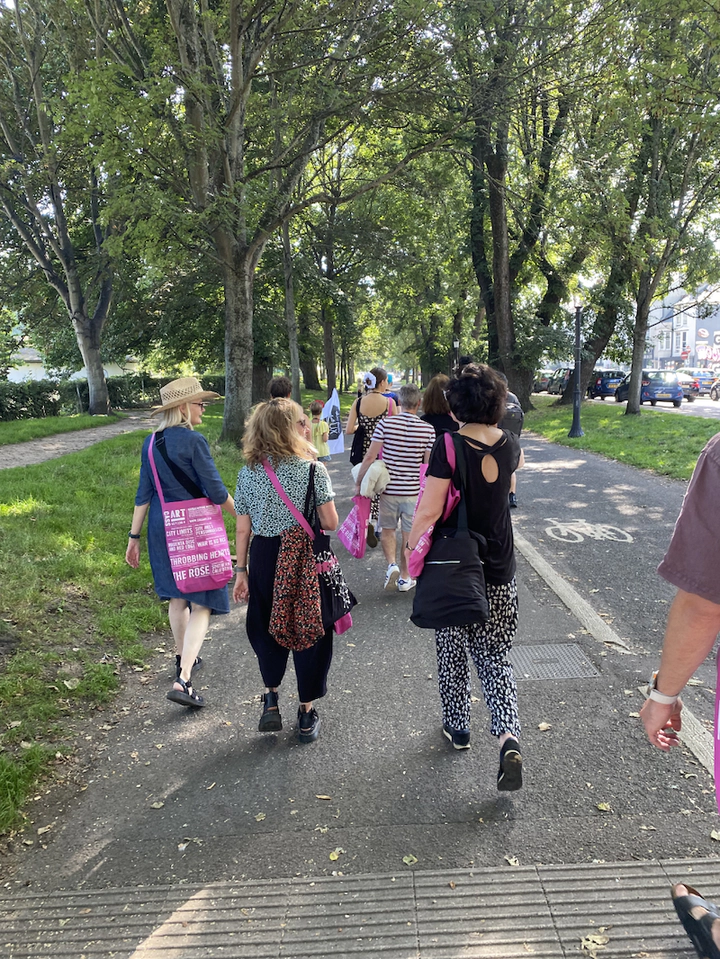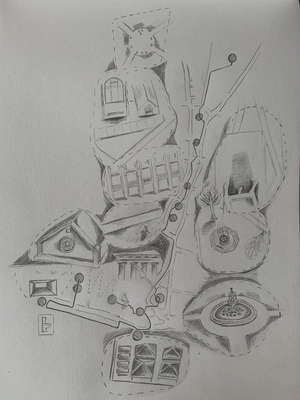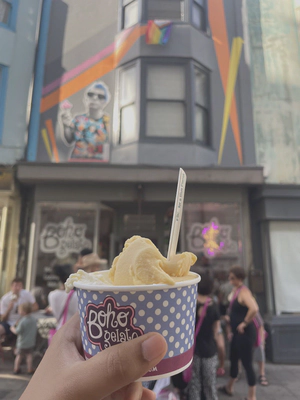Overdue reflections: playing games and taking walks
Pausing to reflect on things I have done recently…
 Ladies that UX Walk, September 2023. Photo by Heidi Swigon.
Ladies that UX Walk, September 2023. Photo by Heidi Swigon.
Previously on Fiona’s blog…
My last post was immediately before trying out a new version of the ‘These UXers Need Help’ game. This post follows that and reflects on a recent Design Walk I devised and led.
Today’s method via Aristotle
“Who, When, Where, Because, What, How”.
Most designers have probably heard of the ‘five W’s’. They may or may not know of its origins in Aristotle’s book 3 of Nicomachean Ethics1 as a set of seven circumstances to understand a situation. Newer translations of the text bring added clarity to the original intention of the thinking method.
“Therefore it is not a pointless endeavor to divide these circumstances by kind and number: (1) the who, (2) the what, (3) around what place or (4) in which time something happens,and sometimes (5) with what, such as an instrument, (6) for the sake of what, such as saving a life, and (7) the how, such as gently or violently”
(Aristotle, Eth. Nic. 1111a3–8, as translated by Sloan, 2010, p.239).
It is the “for the sake of” bit that interests me. When did it become ‘why’? Recently, while reading Indi Young’s Time to Listen2, I realised that ‘why’ is not the most decisive question when working on listening sessions. ‘Why’ is that? Young posits that asking why does not help guide people to their inner reasoning and “interior cognition” (Young, pp. 128-179). She also notes, and I agree, that ‘why’ can be irritating when repeated more than once in an interview or listening session. From my practice, I also know that when you work with people working in highly codified environments, and you ask a ‘why’ question you are more likely to receive the organisations’ reasoning not their own. So, in this post, I am experimenting with Indi’s suggestion to use ‘because’ as a substitute for ‘why’.
These UXers Need Help - version 2.0
Prompts for the questions below are based on Curedale (2013, p.255)3.
Who…
…is involved?
UXup invited me to be part of their evening meetup on the 20th July 2023. There were about 25 people. The folks in the room are involved in different UX-related fields with a range of experience.
…is affected?
People in the room may have personal experience with some of the issues raised by the cards. This makes it essential to establish the rules of the gameplay early. For instance, different cards can be requested to replace the randomly drawn cards. Also, where personal experiences are shared, those who do not have those experiences listen to those who do.
…needs the problem solved?
On one level, this session took some of the runtime of the event. On a meta-level, it is a game to encourage and build empathy. A core capability for all designers of solutions for humans.
When…
…did it happen?
It happened towards the end of the event, and we ran out of time. This meant we had one practice round as an entire room, followed by one independent round.
…is the solution, this game, needed?
A few possibilities are listed below. When a group or team are…
- …about to embark on a fresh research project.
- …trying to calibrate and get to know each other.
- …thinking about ways to give back to the UX community.
Where…
…is the situation?
The Pump House pub was a great venue for the game as there were spacious tables to work with the cards and game sheets. Currently, the game is designed to be played in person. It would be easy enough to play over a web call using photos of the drawn cards from the deck or a randomising spreadsheet (as a way to prototype it).
Because…?
The raison d’etre
To build empathy in an applied and fun way. This game is about considering the life surrounding your practice as a designer and how that life can sometimes make it hard to be a designer. The goal is to help players to become more attuned to the way that situations, personal talents, attitudes, attributes, skills, and power and set someone up for success or place barriers in front of it.
For the sake of…because?
It is rooted in my personal set of values. I have a passion to do something about making sure design is both inclusive, introspective, and reflective on a continual path of improvement. I want to share this passion with others. I want them to be infected by my enthusiasm. ‘Because’ ultimately, none of us are here for long, and if you find ways to help improve other people’s circumstances, what better legacy is there? You can achieve this through ‘design’ by thinking about the design of everything you do.
What…
For more on the ‘what’ check out my earlier blog posts about the game:
…are its weaknesses?
Sometimes, because the cards are open to interpretation, they can lead to a surface-level conversation when more depth is the goal. To solve this, testing and removing cards that have to be explained or could be performing better is essential. I did like the situation card ‘is transitioning from one state of being to another’ as it was interpreted as the move from graduate school to work, which is an entirely valid situation to discuss. One which can be fraught and particularly challenging in the current jobs market.
Another weakness is that the game really does need two independent rounds to work. Due to the luck of the draw, having two rounds gives the opportunity to have a round that has greater depth or ambiguity. Having only one independent round means it is essential for a warm-up only. I will do this differently next time and ensure a minimum of 30 minutes is allocated. That was beyond the scope of this event, where only 20 mins was given. It was still a valid opportunity to user-test the game.
How
This is the most significant area for improvement. The way I displayed the game using my phone and a display adapter for the screen in the room did not work well. In future, I will either use an external webcam with my laptop or take a photo with my phone and share it with my laptop screen. In both approaches, a laptop with a display adaptor would work more consistently with a display screen in the room. This would also allow me to move around more freely.
Closing thoughts
I am grateful to have had a chance to use the game with a group again. I was asked if I might consider extending the game at some point. The main thing would be to capture some of the suggested solutions for the scenarios. These could be taken forward as ideas or commitments. Devising solutions also relies on a mixture of experience in the group so that knowledge of available solutions is forthcoming. A more accessible version of the game might need to offer solution cards. For instance, ‘find a mentor’, ‘join a meetup group’, ‘attend a conference’, ‘ask for help on Slack’, ‘check out the latest design articles’, ‘find a career coach’, ‘speak to HR about career options’, etc. There is also a risk that solution cards could restrict the creativity of the suggestions provided.
Ladies that UX Design Walk
Who…
…is involved?
Those who opted to attend the first Ladies that UX Brighton walk. Some of these folks come to LTUX events regulary. Many were attending their first event. There was a mixture of ages from under 10s to folks over 60. Having such a group of interested people to walk and converse with was a rare privilege!
…is affected?
The walk did touch on sensitive topics, so it was important to let people know that at the beginning and to provide options for them to opt out of elements or leave early. Strangely, it was also the hottest day of the year, so that impacted all of us and the design that had to be adapted ad hoc.
…needs the problem solved?
The problem was grounded in the disconnection you can feel as a designer working in a digital and built environment. How can we find inspiration amidst distractions? How can we find quiet in the noise? The walk was about sharing creative methods for perceiving and imagining our city in new ways.
…helped me?
Designing an activity for people absolutely has to involve people. So, I asked several folks for feedback. Their thoughts and feedback helped me to refine and iterate the design.
- Ellen Mueller: Ellen’s artistic practice includes organising walks, and has just written a book, ‘Walking as Artistic Practice’ (2023). My chat with Ellen helped me think about ways to design the walk to care about the walkers and demonstrate that care. Ellen’s work and this reading list on her website were the primary sources of inspiration for the walk.
You can check out the reading list for the walk here.
-
Kate Shields: chats with Kate about all things art and walking definitely informed the design. Having attended virtual role-playing-game walks led by Kate on Twitch, rambling through the environments of Assasin’s Creed, Kate’s artistic practice is a great source of inspiration. For more check out Kate’s blog.
-
Heidi Swigon: early chats with Heidi gave me the confidence to believe that folks would sign up to spend a Saturday afternoon walking with me! Heidi’s enthusiasm for some of the topics I was planning was like rocket fuel for my creative process. Heidi also helped put together the accompanying zine, contributing the front cover and other design flourishes. The zine was given to each walker on the day. Heidi also took photos and helped to re-find people during an activity during the walk. Big gratitude!
-
Suse Bentley: provided a vital listening ear more than once. The first time, we talked about the intentional act of walking as women in urban environments. The second time was when I needed to sense check an aspect of the walk to ensure I was handling it from a position of interest and understanding.
I am immensely grateful to everyone who helped me think through and produce the walk design. A special thank you to Viv Cohen, too.
As an aside, something that fed into the walk design was the gentrification of walkable urbanism, the walkable city as designed by architects and city/town planners. I was particularly interested in how this concept relates to the ongoing redevelopment of The Level down to the sea front4. Walkable urbanism is oft conceptualised through architectural mock-ups featuring stylised female characters ‘walking’ through these imagined future spaces, providing their seal of approval (Bieri, 2015 & 2017)5. Through their presence, these characters give a sub-conscious message: yes, this space is trendy; yes, this space is safe; no, this space is not for everyone, for if it were, it would not be trendy or safe. I am personally a huge fan of walkable cities, yet it is important to consider that those who benefit the most from walkability are those who can afford inner-city housing price tags.
When…
…did it happen? Rescheduled to the 9th of September from July. As a note, unseasonably, this was the hottest day of the year. At 2pm in the afternoon, it was also at the peak of the heat, reaching 33.2 degrees Celsius (91.8 degrees Fahrenheit)6.
…is the solution needed? The walk was structured as a story with a series of interventions along a planned journey, starting at The Level and ending at the Laines in Brighton. The story was mapped to the spine structure that Ellen de Vries provided at her session on facilitation at Ladies that UX Brighton in May 2023. As outlined below.
- Context
- The Question
- Guidance/Intervention
- Encounter
- Transition/adrenaline push
- Resolution
Alongside the points above, I considered how the design council’s double diamond could feed into this - as a researcher, it seems important to start with discovery. Yet, I also felt that we might need to complete some extra work to enable ourselves to become more open to discovery, and this is where a meditation exercise came in as an early addition to the walk. A mental cleanse of sorts.
Where…

Locations planned:
- Union Road, The Level next to the skate park.
- North of St. Peter’s Church, York Place, The Level.
- South of St. Peter’s Church, York Place, The Level.
- Mazda Fountain, Victoria Gardens.
- Memorial to nothing, Victoria Gardens.
- Old Steine Gardens.
- Disco Balls - Seafront next to OHSO Social.**
- Subway next to Shelter Hall.**
- Middle Street.**
- Ship Street Gardens.**
- St. Bartholomew’s Road.**
- Poole Valley.
**Starred locations were skipped for reasons I’ll explain.
…is the situation? The heat and busyness of Brighton made it difficult to walk at speed, and being outside was unpredictable. For instance, at the ‘memorial to nothing’ location, the remnants of a dead bird were scattered around it making it sad and unpleasant to stay there. We acknowledged the bird and the unpredictable nature of walking outdoors and moved on.
Because…?
The raison d’etre To explore our city as designers together.
For the sake of…because? I had a drive to share things I had discovered about our city by walking and running around it during the pandemic. Something that I have continued to do. This city has the capacity to provide neverending intrigue and wonder. It is constantly changing and evolving. For me, a big part of Brighton’s design is the people in it and their performative individuality; the unique clothing styles, mannerisms, and theatre of it all that I find endlessly intriguing.
What…
…are its weaknesses?
I tried to pack too much into the walk, and this was exacerbated by the extreme heat which meant we had to find different places to stand together. Next time I would plan half the stops we had planned in the zine.
What attendees said in the event feedback:
- Suggested an extended event starting in the morning, breaking for lunch, and continuing into the afternoon.
- A more focused narrative, such as focusing on specific design choices and changes over time, or accessibility and inclusivity (this is definitely a walk I’d like to do in the future!).
- Checking for other events that are on at the same time. As we had to change the date, this was always going to be a risk and there is always a lot going on in Brighton. A funfair on The Level and a competition in the Skate Park proved challenging at the beginning of the event - it made it hard to find people and was loud.
They liked…
- The high level of preparation and organisation.
- The rich discussions and variety of perspectives brought by fellow walkers.
- For a time, it changed their perception of their surroundings.
- The zine and accompanying reading list.
- The free gelato and art materials.
…was unexpected?
A group of young men decided to join our group near St. Peter’s church and listened to what I had to say. When I asked them if I could help, they asked if they could join our protest. It is interesting that a group of less than twelve, majority women, walking along a street was perceived as a protest. But then context is everything; The Level has a long history of public assembly.
How
I did foresee that we might run out of time, so I built a real-world cheat code by planning a lane that allowed us to skip multiple stops and go to the end - Boho Gelato in the Poole Valley. This was an excellent plan, and I will continue to think about how role-playing games can provide inspiration across my creative practice.
Closing thoughts
I learned a lot by pushing myself out of my comfort zone for this walk, and I will definitely plan walks again. A realisation for me is how hard it is to plan an event in space, time, and motion. I am experienced in “space” and “time” due to my many years of teaching and running workshops, but traversing space over a set period of time definitely adds complication. Also, giving people time to explore an area independently and then regroup is nerve-wracking. I feared that we would not find each other again, and if it hadn’t been for Heidi’s help gathering people, we might not have. The bright pink bags with our art materials definitely helped - the whole tour guide thing of all having the same hat or backpack makes total sense!
A big thank you to all those who attended the event and contributed feedback.

References
-
Sloan, M.C. (2010) ‘Aristotle’s Nicomachean Ethics as the Original Locus for the Septem Circumstantiae’, Classical Philology, volume 105/3. doi:https://doi.org/10.1086/656196. PDF available at Academia.ed. ↩︎
-
Young, I. (2022) Time to listen - How giving people space to speak drives invention and inclusion. USA: Indi Young Books. ↩︎
-
Curedale, R. (2013) Service Design - 250 essential methods. CA: Design Community College Inc. ↩︎
-
Anja Hälg Bieri’s work was part of this amazing book I found in the research process, Hall, C. M., Ram, Y., Shoval, N. (Eds.)The Routledge International Handbook of Walking (2018). ↩︎
-
‘British heatwave brings hottest day of 2023 so far’, Reuters. Available at the Reuters website. ↩︎